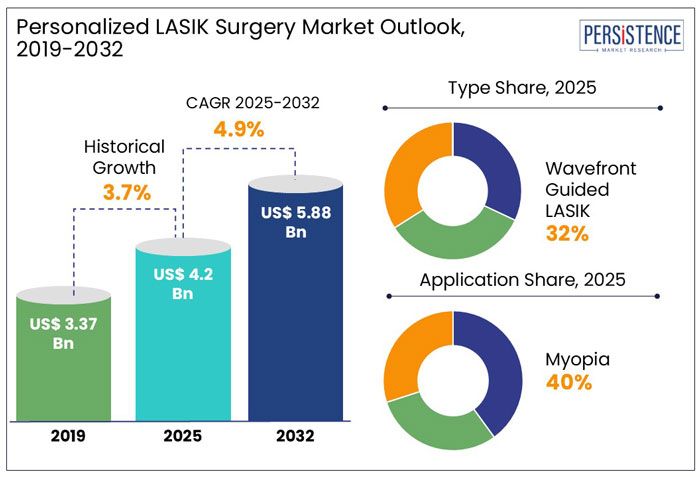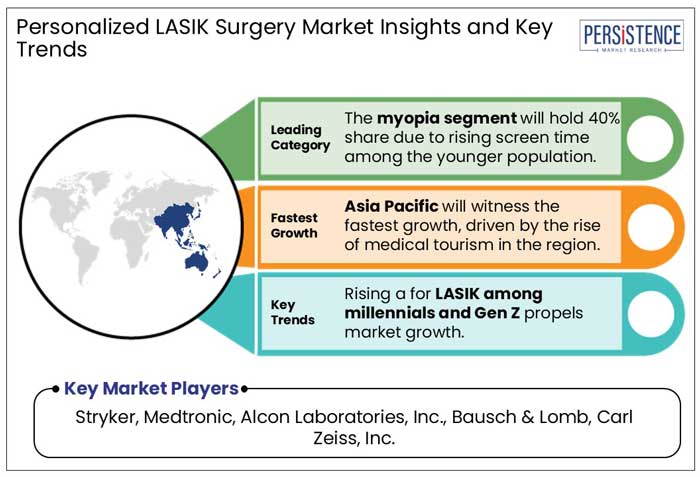Industry: Healthcare
Published Date: March-2025
Format: PPT*, PDF, EXCEL
Delivery Timelines: Contact Sales
Number of Pages: 250
Report ID: PMRREP12346
The global personalized LASIK surgery market size is anticipated to rise from US$ 4.20 Bn in 2025 to US$ 5.88 Bn by 2032. It is projected to witness a CAGR of 4.9% from 2025 to 2032.
The market for personalized LASIK surgery has experienced notable growth over the years, driven by technological advancements and the increasing prevalence of refractive disorders.
The introduction of advanced platforms, such as the iDesign platform by AMO, which scans the patient's eye more than 25 times to develop a unique blueprint, has enhanced the precision and outcomes of personalized LASIK surgeries.
Notably, 98% of patients who have undergone personalized LASIK surgery with such technologies have not experienced any post-surgery side effects.
The increasing incidence of refractive disorders, particularly myopia, has contributed to the growing demand for personalized LASIK surgeries. This trend is observed across various age groups, emphasizing the need for effective vision correction solutions.

Key Highlights of the Personalized LASIK Surgery Market
|
Global Market Attributes |
Key Insights |
|
Personalized LASIK Surgery Market Size (2025E) |
US$ 4.20 Bn |
|
Market Value Forecast (2032F) |
US$ 5.88 Bn |
|
Projected Growth (CAGR 2025 to 2032) |
4.9% |
|
Historical Market Growth (CAGR 2019 to 2024) |
3.7% |
Rising Cases of Refractive Disorders Aided Market Growth
During the historical period from 2019 to 2024, the global market experienced steady growth, driven by rising cases of refractive disorders like myopia and astigmatism.
For decades, vision correction relied on traditional eyeglasses and contact lenses. However, as technology advanced, personalized LASIK surgery emerged as a game changer, offering customized solutions tailored to an individual’s eye structure.
Increasing screen time, digital eye strain, and genetic predisposition contributed to the demand for vision correction. However, limitations in accessibility and high costs slowed adoption in certain regions.
Advent of AI-Driven Diagnostics to Boost Market Revenue
Over the forecast period, the market is poised for significant transformation with technological advancements, such as topography-guided LASIK and wavefront-optimized procedures, which will redefine precision and safety.
The rise of AI-driven diagnostics and robot-assisted surgeries will further enhance outcomes, reducing risks and making LASIK a preferred choice. With improved accessibility, lower costs, and enhanced customization, personalized LASIK surgery is set to revolutionize vision correction worldwide, bringing sharper clarity to millions.
Rising Prevalence of Refractive Disorders and Digital Eye Strain Drives Market Forward
Refractive disorders like myopia, hyperopia, and astigmatism are continuously rising, which is a major market driving factor.
The increasing dependence on digital screens for work, education, and entertainment has further worsened digital eye strain, leading to deteriorating vision at a younger age.
Personalized LASIK surgery has emerged as a permanent vision correction solution, offering customized laser treatments tailored to each patient’s unique eye structure. As more individuals seek long-term freedom from glasses and contact lenses, the demand for advanced LASIK procedures will continue to rise, fueling market growth.
Risk Perception and Post-Surgery Complications May Impede Market Growth
Despite its high success rate, LASIK surgery is still perceived as a risky procedure by many potential patients. Concerns over side effects such as dry eyes, glare, halos, and fluctuating vision deter individuals from opting for surgery.
Although advancements in wavefront-guided LASIK and femtosecond lasers have significantly reduced risks, fear of complications remains a major psychological barrier. Post-surgery recovery, while typically short, can involve temporary discomfort and visual disturbances, which some individuals find unsettling.
Addressing these concerns through better patient education, surgeon transparency, and technological refinements will be crucial in overcoming this restraint and fostering greater trust in personalized LASIK procedures.
Rising Demand for LASIK Among Millennials and Gen Z Augments Market Growth
The younger generations are leading a major shift in elective eye surgery trends. With increased screen time due to digital devices, online work, and gaming, millennials and Gen Z are experiencing higher rates of myopia (nearsightedness) than any previous generation.
The said demographic is also more inclined toward lifestyle-enhancing medical procedures, making LASIK a preferred alternative to glasses and contact lenses. Unlike older generations who hesitated due to fear of surgical risks, younger patients trust technology and seek long-term vision correction solutions.
Several tech-savvy professionals and fitness enthusiasts prefer LASIK over traditional eyewear due to its convenience, aesthetic benefits, and improved quality of life. As demand from younger consumers rises, the LASIK market will continue to thrive, pushing innovation in laser vision correction.
Wavefront Guided LASIK Dominates with 32% of the Market Share Owing to its Enhanced Visual Outcomes
Wavefront-Guided LASIK utilizes advanced wavefront technology to create a detailed, three-dimensional map of the eye's unique imperfections. Comprehensive mapping allows surgeons to tailor laser treatments with exceptional precision.
It helps address common refractive errors like myopia, hyperopia, astigmatism, and subtle irregularities known as higher-order aberrations. By correcting these imperfections, patients often experience sharper vision and reduced visual disturbances such as glare and halos.
The prominence of Wavefront-Guided LASIK in the market for personalized LASIK surgery underscores the industry's commitment to leveraging cutting-edge technology to enhance patient outcomes. As awareness grows and technology continues to evolve, this segment is poised to maintain its leading position, offering patients a reliable solution for precise vision correction.
Myopia Leads with 40% of the Market Share Due to Increased Screen Time Among Younger Generation
Myopia, commonly known as near-sightedness, impairs the ability to see distant objects clearly, while close vision remains unaffected. The myopia condition has seen a marked increase globally, with studies indicating that nearly 30% of the world's population was affected by myopia in 2023, a figure projected to rise to 50% by 2050.
The surge is particularly pronounced among younger demographics, attributed to factors such as increased screen time and reduced outdoor activities. The dominance of myopia in the market for personalized LASIK surgery underscores a broader trend toward customized medical solutions that cater to individual patient needs.
As the prevalence of myopia continues to rise, the demand for personalized LASIK procedures is expected to grow in tandem, driving further advancements in refractive surgery technologies and techniques.

North America accumulated 41% of the total market share globally. The market is predominantly influenced by the expanding elderly demographic, which increasingly pursues corrective eye surgery, particularly LASIK, to enhance their vision. The increasing prevalence of eye care centers in the region provides tailored LASIK treatments, thereby enhancing the accessibility of the procedure.
The US market for personalized LASIK surgery is primarily driven by a growing patient preference for individualized procedures over cataract surgeries.
The country, characterized by a substantial and varied population, offered a considerable patient demographic that increasingly favored minimally invasive surgeries. Patients value benefits such as abbreviated hospitalizations and less blood loss, which facilitate market expansion.
Europe is one of the leading regions in the global market for personalized LASIK surgery, driven by a combination of technological advancements, increasing awareness, and a strong healthcare system.
European eye care clinics are early adopters of cutting-edge LASIK techniques, including wavefront-guided and topography-guided LASIK. Such precision-driven solutions have gained popularity due to their ability to provide better visual outcomes, fewer complications, and improved night vision.
Europeans are increasingly opting for minimally invasive medical procedures, including LASIK, SMILE, and PRK surgeries, due to their quick recovery times and long-term benefits. The increasing number of pre-screening and post-operative LASIK care centers has also contributed to market growth in the region.
Asia Pacific is the fastest-growing region globally, fueled by high myopia prevalence, rising disposable incomes, and increasing medical tourism.
Asia Pacific has become a global hotspot for LASIK medical tourism, with countries like India, Thailand, and Malaysia offering high-quality LASIK procedures at a fraction of the cost compared to North America and Europe.
Patients from North America, Europe, and the Middle East travel to these countries for cost-effective, high-quality vision correction procedures. Apart from being a hotspot for medical tourism, Asia Pacific is anticipated to have rapid urbanization, which could be a pivotal market-driving element.
With rapid urbanization, rising disposable incomes, and an expanding middle class, more people in China, India, Indonesia, and Vietnam are investing in elective medical procedures like LASIK, which is eventually aiding the region's growth in the market.
The market for personalized LASIK surgery is highly competitive, with leading ophthalmic technology companies, specialized laser surgery centers, and innovative startups vying for market dominance.
Major industry players are investing in cutting-edge laser platforms such as wavefront-guided and topography-guided LASIK to enhance surgical precision. Independent LASIK centers and eye hospitals are also expanding, offering personalized vision correction procedures with flexible financing to attract younger demographics.
The rise of medical tourism in the Asia Pacific and the growing adoption of femtosecond laser technology are further intensifying competition. As consumer demand for minimally invasive vision correction grows, companies focusing on technological innovation, affordability, and superior patient outcomes will shape the future of the LASIK surgery market.
Key Industry Developments
|
Report Attributes |
Details |
|
Historical Data/Actuals |
2019 - 2024 |
|
Forecast Period |
2025 - 2032 |
|
Market Analysis Units |
Value: US$ Bn/Mn, Volume: As applicable |
|
Geographical Coverage |
|
|
Segmental Coverage |
|
|
Competitive Analysis |
|
|
Report Highlights |
|
|
Customization and Pricing |
Available upon request |
By Type
By Application
By End Use
By Region
To know more about delivery timeline for this report Contact Sales

The market is set to reach US$ 4.20 Bn in 2025.
Stryker, Medtronic, Alcon Laboratories, Inc., are a few leading players.
The industry is estimated to rise at a CAGR of 4.9% through 2032.
North America is projected to hold the largest share of the industry in 2025.
The market is anticipated to reach a valuation of US$ 5.88 billion by 2032.